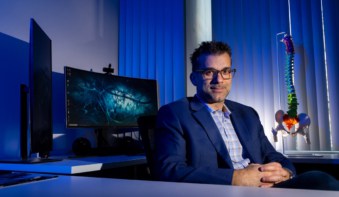
Injuries to the lumbar spinal cord severely impair leg movement, or even cause complete paralysis. Epidural electrical stimulation has emerged as a promising approach to restore motor control, but for severe injuries, recovering movement also requires a serotonergic replacement therapy. With this aim, a research team headed up at EPFL in Switzerland is developing neural interfaces that deliver both electrical and chemical neuromodulation to the spinal cord.
These interfaces, called “e-dura”, integrate a silicone substrate, stretchable gold interconnects, soft electrodes and a fluidic microchannel (chemotrode). Unlike existing implants, these can be inserted below the dura mater – the membrane surrounding the spinal cord – allowing highly targeted drug delivery.
“E-dura has mechanical properties that are similar to those of the dura mater itself,” explained first author Marco Capogrosso. “Therefore, biomechanical compliance is greatly improved compared with classical stiffer electrodes. This allows the implants to gently ‘sit’ on top of the cord without significant damage to surrounding structures.”
This subdural placement should also increase the selectivity of electrical stimulation and reduce current thresholds. To date, however, these advantages have not been validated. Capogrosso and colleagues have now combined in silico, in vivo and behavioural experiments in rats to evaluate the advantages of subdural implants for restoring motion via electrochemical stimulation (J. Neural. Eng. 15 026024).
In silico simulations
To compare the spread of currents between epidural and subdural implants, the researchers developed a computational model of the rat spinal cord that included detailed geometry of the spinal roots. They first estimated the 3D voltage distributions elicited by stimulation from electrical contacts placed within the epidural fat (above the dura mater) and within the cerebrospinal fluid (below the dura mater). Iso-potential curves penetrated deeper into the dorsal roots (which contain the nerves involved in muscle activation) with the subdural electrodes.

They then used these voltage distributions to simulate electrical stimulation, finding that subdural stimulation recruits spinal structures at lower currents than epidural stimulation. The model estimated that subdural stimulation reduces the activation threshold by 10–20% compared with epidural stimulation. This reduction is attributed to the proximity of subdural electrodes to the targeted neural structures.
In vivo studies
Next, Capogrosso and colleagues validated the model in rats, using the same implant to deliver epidural and subdural spinal cord stimulation. In five rats, the electrode was first placed above the dura mater to perform epidural stimulation, then the dura mater was opened and the device was inserted below. The researchers delivered electrical pulses at increasing currents until motor responses recorded in leg muscles reached saturation.

Subdural and epidural electrical stimulation both achieved a graded recruitment of the distal leg muscles. Confirming the model’s predictions, subdural stimulation showed an average 15% reduction in current threshold compared with epidural stimulation. Stimulation delivered from the subdural and epidural surfaces achieved comparable, high levels of specificity, allowing side-specific recruitment of leg muscles.
The subdural implant’s ability to decrease stimulation thresholds while retaining high specificity reduces power consumption and risks of long-term damage in the tissues, increasing the clinical safety profile of this approach. The researchers confirmed the stability and safety of the implants in three rats, showing that the electrode threshold and impedance were stable over five weeks. Post-mortem assessment revealed that the implants did not damage the spinal tissue.
Restoring motion after injury
Finally, the team tested the ability of subdural implants to deliver electrochemical neuromodulation therapies. They inserted an implant with seven electrodes and a chemotrode below the dura mater of lumbar segments in six rats. The rats subsequently received a lateral hemisection of the spinal cord. In the weeks after this injury, all rats exhibited complete paralysis of the leg on the injured side, while the other leg could still produce movement when the animals were placed over a treadmill (attached to a body support).
For each test session, the researchers first delivered serotonergic therapy through the chemotrode, and then applied electrical stimulation to the rat’s injured side. This electrochemical neuromodulation restored weight-bearing locomotion of the paralyzed leg in all rats, without affecting the intact leg.
This ability to deliver chemical and electrical neuromodulation simultaneously via a single implant is of great value for clinical translation. “Right now, systemic delivery of drugs would significantly affect the behaviour and mood of patients,” Capogrosso explained. “To allow safe delivery of a sufficient amount of drug to the spinal circuits, we think that local drug delivery is a viable solution. This may be the only option for people suffering from severe motor paralysis to be able to efficiently use electrical stimulation of the spinal cord to recover motor function.”
Next, the researchers aim to demonstrate that spinal cord stimulation is as effective in humans as it is in rats, using classical stiffer epidural interfaces. “If this is the case, all the work that we performed in rats and primates can be translated to clinical settings, including subdural interfaces,” said Capogrosso. “However, e-dura is still an experimental device and significant work needs to be done to scale this technology to human applications.”



